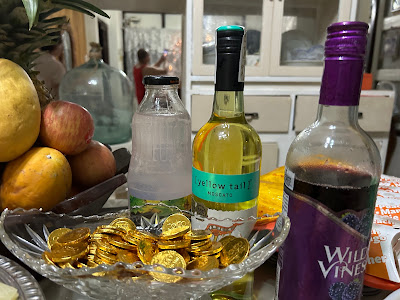Though the new year is barely a day old but already it seems to be full of life and of course, gastronomic delights starting with this traditional midnight meal welcoming the year ahead.
Our media noche is always a mix of the traditional and all-time favorites mingling with the new food finds! So check out our fare welcoming 2024…
Always present is the HAM. Be it the sliced pork ham (Chinese-style) or whole chicken hamonado.
Another staple is a PASTA DISH but this time it was create your own. Linguine pasta with tuna-tomato, pork tomato, tuna, olive pil and pesto as sauce choices with Parmesan cheese.
Something new was the pepperoni QUESADILLA to give our media noche some Mexican flair.
Also some NACHOS to create some texture and flavor with its spicy cheese and creamy spinach dips.
Another staple is QUESO DE BOLA - perfect for that ham & cheese sandwich.
Adding carbo is the BAM-I mixed wit pork, seafood and veggies.
The one I really gorged on was the PANCIT MOLO with the dumplings from ready made from Kap Ising and a home made broth with lots of chicken strips and topped with fried garlic and chopped fresh kusay.
Some gold coins (a prelude to the Chinese New Year) and wines….
… and some fruits. Not complete 12 nor 13, though.
The other side - also with some gold coins and wine for symmetry.
How about a lightly creamed BUKO SALAD?
And some SUMAN LATIK just to fulfill a Filipino belief to have something sticky in welcoming the new year.
Some MINI DONUTS and REVEL BARS for dessert.
An appetizer or main is CHICKEN MACARONI SALAD.
Adding color, flavor and texture is the BUKO PANDAN gelatin with real macapuno strips.
Some MANGO FLOAT, another Pinoy staple during parties
Perfect center is the FRUITTY FOUR SEASON TORTE (Peach Fuzz) from Tinapayan Bakeshop
And finishing off this list is my favorite STOLLEN BREAD also from Tinapayan Bakeshop and CHOCO BANANA PIE from Jollibee.
Our media noche has always been a light to heavy snack. It isn’t like a fiesta fare that comes with rice and lots of meat dishes. But no matter what food is one the table or how we celebrate it, the most important is outlook of optimism for the upcoming year.
Happy 2024!






















Comments
Post a Comment